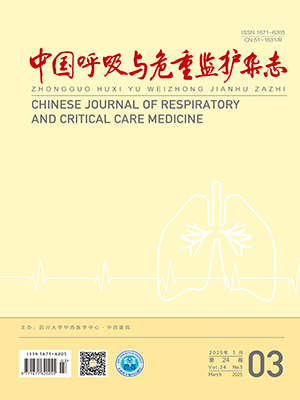Objective To evaluate the clinical features and complications of bedside tracheal intubation in intensive care unit ( ICU) , and explore the suitable strategy of intubation. Methods In this retrospective study,42 patients who underwent bedside tracheal intubation in ICU during September 2008 and March 2009 were divided into a schedule group ( n =24) and an emergency group ( n =18) . The time to successful intubation, number of intubation attempts, and complications were recorded. The schedule group was defined as those with indications for intubation and fully prepared, while the emergency group was defined as those undergoing emergency intubations without full preparation due to rapid progression of disease and accidental extubation. Results The success rate for all patients was only 57. 1% on the first attempt of
intubation. The main complications during and after induction were hypotension ( 45. 2% ) and hypoxemia ( 50. 0% ) . Compared with the emergency group, the schedule group had fewer attempts to successful intubation ( 1. 71 ±1. 12 vs. 2. 67 ±1. 75) , higher success rate on the second attempt ( 87. 5% vs.61. 1%) , and lower ypoxemia incidence ( 29. 1% vs. 77. 8%, P lt; 0. 05) . Conclusions The tracheal intubation in ICU is a difficult and high risk procedure with obvious complications. Early recognition of
patients with indications and well preparation are critical to successful bedside intubation.
Citation:
YIN Wanhong,WANG Bo,KANG Yan,ZHANG Zhongwei,JIN Xiaodong,LIANG Peng.. Analysis of Tracheal Intubation in Intensive Care Unit. Chinese Journal of Respiratory and Critical Care Medicine, 2010, 9(4): 413-415. doi:
Copy
Copyright © the editorial department of Chinese Journal of Respiratory and Critical Care Medicine of West China Medical Publisher. All rights reserved
| 1. |
Sivilotti ML, Ducharme J. Randomized, double-blind study on sedatives and hemodynamics during rapid-sequence intubation in the emergency department: The SHRED Study. Ann Emerg Med, 1998 ,31: 313 -324.
|
| 2. |
Reynolds SF, Heffner J. Airway management of the critically ill patient: rapid-sequence intulation. Chest, 2005, 127 : 1397 -1412 .
|
| 3. |
邓硕曾, 王连杰. ICU、CCU 紧急气管内插管的有关问题. 临床麻醉学杂志, 1993 , 9: 79 -80 .
|
| 4. |
刘朝良, 颜渊. 纤维支气管镜在困难气管插管中的应用. 中国呼吸与危重监护杂志, 2003, 2: 345.
|
| 5. |
刘芬, 赵文辉, 李声华. 插管次数对手术室外紧急气管插管并发症的影响. 中国急救医学, 2006 , 26: 651-654.
|
| 6. |
Mort TC. Emergency tracheal intubation: complications associated with repeated laryngoscopic attempts. Anesth Analg, 2004, 99: 607-613.
|
| 7. |
Mort TC. The incidence and risk factors for cardiac arrest during emergency tracheal intubation: a justification for incorporating the ASA Guidelines in the remote location. J Clin Anesth,2004, 16: 508-516.
|
| 8. |
杜斌, 主译. 麻省总医院危重病医学手册. 北京: 人民卫生出版社, 2009, 52-53.
|
| 9. |
中华医学会麻醉学分会. 中国困难气道管理专家共识. 临床麻醉学杂志, 2009, 25: 200-203.
|
- 1. Sivilotti ML, Ducharme J. Randomized, double-blind study on sedatives and hemodynamics during rapid-sequence intubation in the emergency department: The SHRED Study. Ann Emerg Med, 1998 ,31: 313 -324.
- 2. Reynolds SF, Heffner J. Airway management of the critically ill patient: rapid-sequence intulation. Chest, 2005, 127 : 1397 -1412 .
- 3. 邓硕曾, 王连杰. ICU、CCU 紧急气管内插管的有关问题. 临床麻醉学杂志, 1993 , 9: 79 -80 .
- 4. 刘朝良, 颜渊. 纤维支气管镜在困难气管插管中的应用. 中国呼吸与危重监护杂志, 2003, 2: 345.
- 5. 刘芬, 赵文辉, 李声华. 插管次数对手术室外紧急气管插管并发症的影响. 中国急救医学, 2006 , 26: 651-654.
- 6. Mort TC. Emergency tracheal intubation: complications associated with repeated laryngoscopic attempts. Anesth Analg, 2004, 99: 607-613.
- 7. Mort TC. The incidence and risk factors for cardiac arrest during emergency tracheal intubation: a justification for incorporating the ASA Guidelines in the remote location. J Clin Anesth,2004, 16: 508-516.
- 8. 杜斌, 主译. 麻省总医院危重病医学手册. 北京: 人民卫生出版社, 2009, 52-53.
- 9. 中华医学会麻醉学分会. 中国困难气道管理专家共识. 临床麻醉学杂志, 2009, 25: 200-203.




